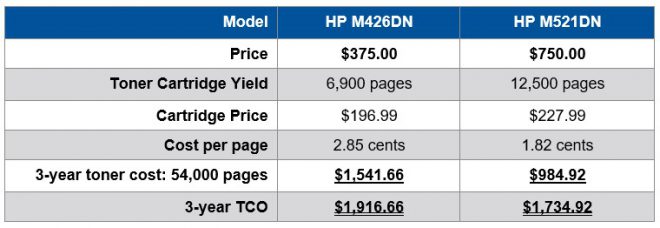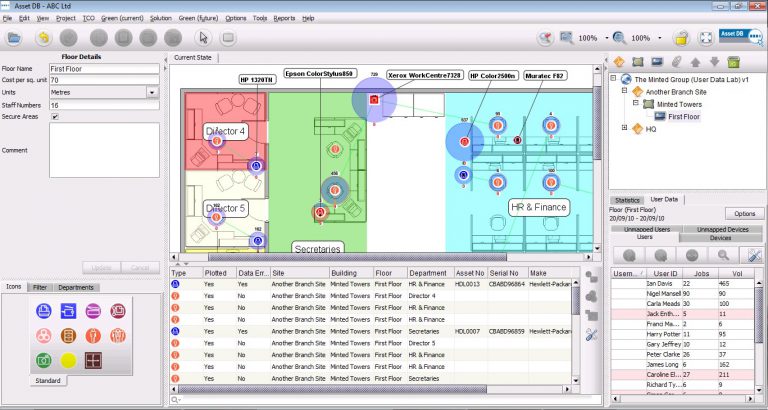Printing expenses, usually the third largest business expense after payroll and facilities, can eat up as much as 3% of a business’ revenue. For all sizes of organizations, this represents a clear opportunity for cost control and waste reduction. In addition, print downtime can kill productivity or bring business to a halt. For small to medium size businesses, making changes or implementing a print strategy can yield large returns on your budget and operation efficiencies. See how making key changes to your print strategy can mean big changes to your business.
An effective print strategy calls for assessing your organization’s needs and resources, weighing all of the costs, risks, benefits and limitations of your printer fleet, and developing a plan that will help you get the most out of your print technology. Many of these components are must-haves for every firm and may be realized without adding a huge burden. To achieve the maximum benefit, identify dedicated, expert print resources, inside or outside your organization.
Measure Print Costs
Many organizations don’t know their total annual print costs. However, print-related spending can consume up to 3% of revenue and represents a significant cost savings opportunity, so a good print strategy begins with a clear understanding of print costs. A good print strategy includes a clear, detailed view of your total print-related costs. And explore all of the ways you can reduce your overall print costs and include security with your new budget.
Write an Effective Print Policy
Print policies cover a wide range of topics, such as ownership of print strategy (typically an IT resource), print device acquisition and placement authority, access to color printing, and requirements for duplex printing. The larger an organization becomes, the higher the stakes, and the greater the need for a clear, well-communicated policy. Even smaller organizations who don’t need a print policy can still reap the benefits from proper management of these concepts.
Limit Waste
Studies show that as much as 40% of printed output — such as printing emails and “banner pages” — is unnecessary, and the average office employee prints 10,000 pages per year. Use printer settings to turn off banner pages, use “print release” functions, or reduce toner density. You can also deploy tools that monitor and manage print behavior, for example, detecting anomalies in printing on a particular device or by a specific user.
Create a Device Acquisition Strategy
A consistent device acquisition strategy includes setting utilization and personnel thresholds (e.g., how busy are existing printers, who uses them, and when does growth call for another device), selecting approved printer models via a sourcing protocol, and communicating the strategy to everyone with purchase authority. Forgoing this results in an environment with too many device models and related consumable SKUs, as well as unnecessarily high support expense. High-cost consumables for “cheap” devices drive up total cost of ownership over time.
Device Placement Strategy
Device acquisition strategies must include determining the physical location of print devices. In optimized, cost-controlled environments, the number of steps required by users to access print should be carefully considered. It is vital to balance device propagation against user productivity. With today’s addition of a supporting a remote workforce, re-evaluating your printer placement and management critical now more than ever.
Consumables Replenishment Strategy
A device acquisition strategy also takes into account consumables management and costs. Key elements include designating who buys toner or inkjet cartridges and in what quantities, where consumables are located, and reorder points. A wide variety of models requires that you stock an abundance of consumables to prevent downtime. But if you limit your environment to fewer models, you can more easily manage a narrower range of consumables. Some skilled print management providers use sophisticated software to monitor levels and deliver consumables on a just-in-time basis, which prevents over-stocking.
Set Up a Consistent Service and Support Model
A smart company recognizes the longer-term value and ROI of business-class devices and that keeping them well maintained over the long term is part of the cost of doing business. Proactive service and prompt onsite service response can also dramatically reduce downtime, as well as accelerate recovery. You’ll need to identify (or outsource) resources who can own proactive, consistent support and service across all locations, define a maintenance schedule, and define a service level commitment that you can balance against the cost to staff that need.
Enact Security Policies and Procedures
Printers and multi-function devices are becoming increasingly more sophisticated, and at the same time, more vulnerable to security threats. Many include disk drives (that store printed information) and even embedded web servers. These concerns — along with the physical security of printed output — make security management a top concern for print environments and a necessary part of a good print strategy. Security steps include a combination of rules (who can print what, where, and when), software (secure print settings, locking out roles from specific printers, monitoring tools, etc.), and device placement policy.
Maximize Sustainability
Strategic print management practices directly support sustainability: controlling device propagation reduces power consumption; managing printed output reduces waste; and deploying business-class devices produces fewer spent consumables. Complete the circle by introducing a consumables recycling program.
Schedule Print Strategy Reviews
The best print strategy includes a regular consultation with dedicated print management resources. Armed with the proper data, these experts can guide an organization in executing a print strategy to achieve less downtime, reduced security exposure and control of costs.
Develop a New Print Strategy
Move out of reactive mode. Start thinking long-term and include your print strategy with your business growth initiatives. You can begin by contacting a managed print company and requesting a free device analysis and print strategy for your organization. To request a review from one of the Secur-Serv print experts you can contact us online by completing a form.



Share